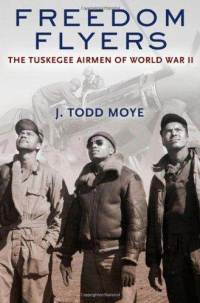Review: Freedoms Fliers by J. Todd Moye April 15, 2012
Author: Beach Combing | in : Contemporary , trackbackWars have the habit of shaking up the social order in a way that a hoary old conservative like Beachcombing finds rather disturbing. Children join militias: think the moving photographs of fourteen and fifteen year German ‘soldiers’ guarding the Atlantic wall or ‘that scene’ in Doctor Zhivago. Gender relations are bent in knots: women are removed rudely from households and thrown onto tractors and into factories. And racial and ethnic respect is burnt like kindling on the barbecue: see every war in the last two hundred years in the Balkans. But let’s say that gender or race relations are no hot shakes to begin with, perhaps war does everyone a favour? Certainly many women recall new freedoms that the World Wars offered them (in their tractors and factories). While for Afro-Americans the pre-war status-quo was hardly worth defending: cue J. Todd Moye’s Freedom Flyers: the Tuskegee Airmen of World War II the Oxford University Press book that Beachcombing has devoured most readily in the last month and its moving story of the first black combat fliers.
If you were black and American in the 1930s the chances are that you would have mixed feelings about your country. If you lived in the southern states you had to bear the disgusting tyranny of Jim Crow and if you lived in the north prejudice was ingrained in society, in the economy and in culture. Come WW2 then black patriots felt understandably torn. On the one hand, they wanted to fight for the flag and American freedoms against some of the most ghastly regimes the human race has ever vomited onto the card table. On the other hand, the flag was oppressing African Americans at home with a uniquely American version of fascism. Not surprisingly many of these soldiers articulated their fight then as a double ‘victory’: against Nazi Germany and other monsters from the deep, but also against attitudes and regulations at home. ‘We find it hard to fight Tyranny in the midst of Tyranny’ as one contemporary put it.
This was all sharpened by the fact that the American armed forces were unquestionably and institutionally racist. For example, there is the incredible fact that blood taken from black and white servicemen was kept separately, though there was and is no scientific justification for such an absurd procedure. With this kind of nonsense we can trace attitudes but there were also actions: the reluctance to use black infantry in battle with the same being employed as something equivalent to Liberty’s navvies. Nor unfortunately did things change very much in the course of the war: one of the most striking passages in this book describes a black pilot being momentarily taken up in the patriotic joy of a welcome in an American harbour only to arrive at disembarkation and be told that he has to walk out onto the dock on a ‘black’ gangplank. This was one of those men who had served his country, risked his life and who had disproved the absurd notion that black men could not fly. And here was his spit-in-your-face homecoming.
Many Second World War books (pioneers in this regard) thrive on witness statements of battles. But Freedom Fliers offers a richer take on the same. As the author is not just tracing the experience of war but also backgrounds and aftermaths – an important part of the book are the changes in life for black Americans – the reader goes deeper. He or she will feel at the end that they’ve read a Russian novel rather than a trashy throw away murder mystery because so much more ground is covered. And Beachcombing should say that if the lives honoured here begin with intolerable domestic conditions they end with an invitation, as guests, to Obama’s inauguration. The Tuskegee airmen took that familiar road from outsiders, to heroes, to icons. And, on the subject of icons, those who enjoy the perversions of history will particularly relish a bit of cobblers in part exposed by this book: the notion that the Tuskegee fliers never lost a plane while escorting American bombers. This claim, which is simply untrue, is a nice example of a half truth becoming a useful lie. The author in one brilliant passage expresses the outrage in popular culture over challenges to this claim thus: ‘But they didn’t every lose a bomber! It says so right here on my T-shirt!’
Beach is always looking out for outstanding WW2 books: drbeachcombing AT yahoo DOT com



